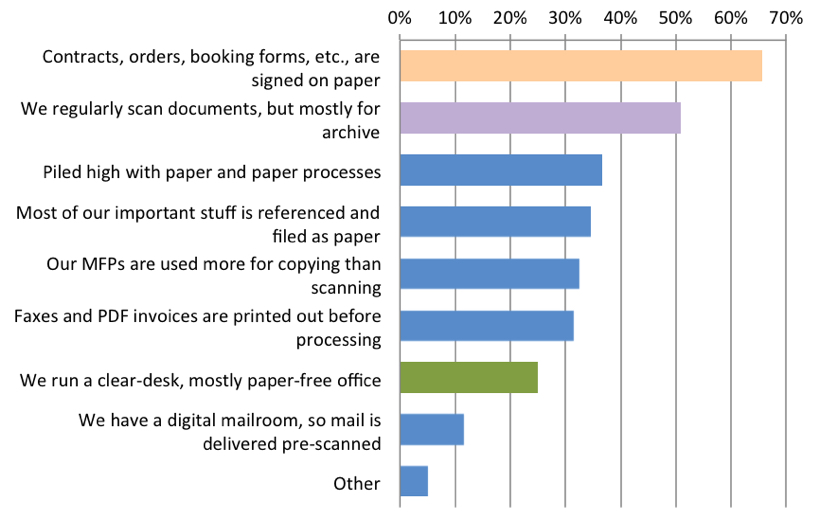
Image by: michaelquirk, ©2016 Getty Images
Since the advent of document imaging, the question around paper use and the challenge of paper reduction remain persistent. Organizations are willing to accept that paper-clogged processes impede their operational effectiveness, and people understand the benefit of an all-digital workplace. Yet, paper is still here.
A new report by AIIM titled “Paper-Free in 2016 - Are we there yet?” shows that while the numbers are up slightly (25% of respondents say they run a clear desk and are mostly paper-free), it is still disheartening to find that most organizations are not readily taking advantage of managing digitally born/created information entirely in digital form. There is clearly room and an opportunity for business organizations to maximize their information use and value as well as lower operating costs by removing paper from their business processes.
The reality for many is that paper still has a stranglehold on day-to-day activities. For example, many processes, like review and approval, still require physical interactions with paper-based information. When we asked our respondents to describe their office or organization, 65% say they are still signing contracts, orders, booking forms, and more on paper, with 51% indicating they regularly scan documents but only to archive.

Figure 1: Which of the following would describe your office or typical offices in your organization?
AIIM 2016 Industry Watch, “Paper-Free in 2016 - Are we there yet?”
Key reasons for this barrier are the challenges associated with change management and a lack of executive-level support when it comes to being paper-free. People like to hold onto a physical piece of content, preferring this format for note-taking, sharing, and, as we’ve seen, signature capture. While management may recognize the importance and the benefits of eliminating paper from processes, they appear to be lacking in providing vision and direction as to how, why, when, and where paper reduction and paper-free processes can and should be implemented.
Consider this
Running a paper-free initiative does not mean you have to eliminate all paper from all processes all at the same time. Being paper-free can mean that you are moving in a direction that will free up vital operational processes by reducing—and, yes, eliminating paper—over time. The key is to look at your processes, identify the paper involved, and assess how and where it can be eliminated, using technology to automate and enhance the process as much as possible.
What to think about
Consider the statistic related to signatures. If this is why you are printing a document, and in many cases, scanning it back in at some point along the process, does it not make sense to incorporate technology that securely allows you to sign that document digitally?
If the reason you are printing is for reading and mark-up, does it not make sense to use the annotation features within your applications to make those suggestions and have that digital version as part of the development trail for future reference?
In my view
For the most part, the greatest limitation to businesses being paper-free is the human factor and a lack of understanding in how to begin removing paper from the business process. If it is born/created digital, it should remain digital and only should be transformed to paper under exceptional circumstances.
If you have begun your journey, I congratulate you and encourage you to continue. If you have not, I challenge you to give it a try and join us on November 4, 2016 for World Paper Free Day to learn how to move forward and hear how others have succeeded.
Bob Larrivee is Vice President and Chief Analyst of Market Intelligence at AIIM and an internationally recognized subject matter expert and thought leader with over 30 years of experience in the fields of information and process management. He is an avid techie with a focus on process improvement and the application of advanced technologies to enhance and automate business operations. Follow him on Twitter @BobLarrivee.
















